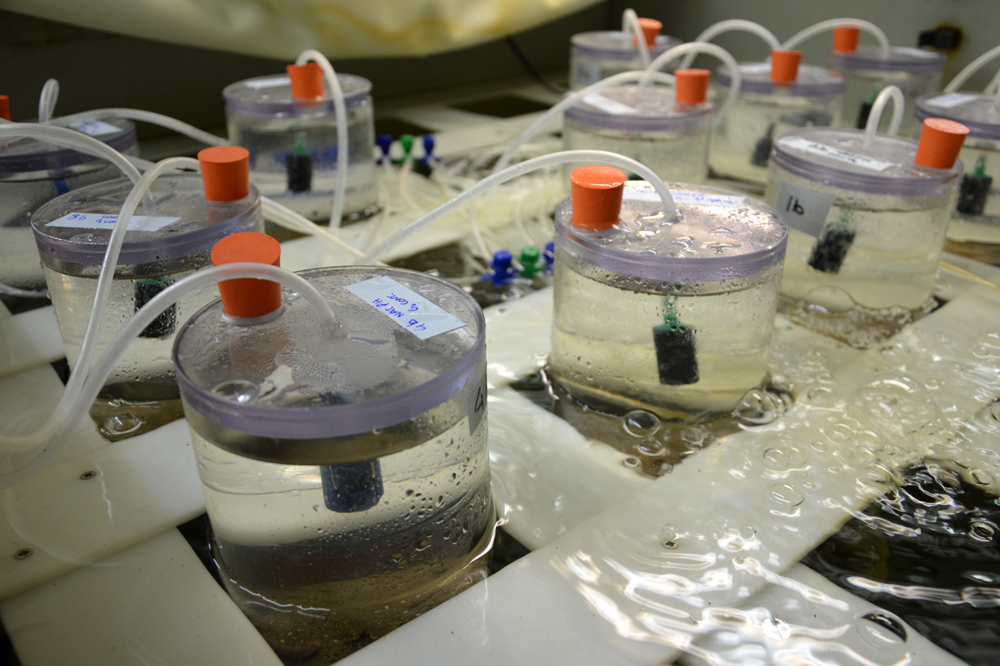Story
Seabed carbon stores threatened by climate change and human activity
19 September 2019
New research suggests that some marine organisms are unable to cope with increasing carbon dioxide and low oxygen events simultaneously, providing fresh understanding of the impacts of multiple stressors on these fragile and poorly understood ecosystems.

Seabed habitats are important because they contribute to the regulation of global climate by serving as carbon stores. Processes carried out by fauna and microbes within these habitats are strong drivers of that storage capacity and the combined effects of increased carbon dioxide (CO2) and low oxygen in the ocean, motivated by climate change, impact both marine sediments and the organisms that live in them.
The team, including scientists from Plymouth Marine Laboratory (PML), the University of Pisa, Southampton University, Florida State University, and funded by the Natural Environment Research Council, carried out a novel mesocosm experiment that mimicked natural conditions in the South West of the UK. This allowed them to assess the effects of both increased CO2 and hypoxia on both the sediment and the organisms living within it.
Increasing CO2 and hypoxia
Increasing CO2 in the atmosphere, driven by rising fossil fuel emissions, acts as a stressor on ocean sediment systems as it causes ocean acidification. This can negatively affect marine animals, such as invertebrates living in and on the sediment, by altering natural processes and food webs.
Low oxygen states in the water and sediment is known as hypoxia. This can occur naturally in some habitats, but it can be artificially driven by humans; when high-nutrient runoff from activities such as agriculture enters the water, stimulating the growth of algal blooms and decreasing oxygen in the water. These low-oxygen conditions, which can also be caused by climate change, can then have serious consequences for organisms living in the affected area.
Organisms unable to deal with stressors in tandem
During the experiment, macroalgae (seaweed) were chemically labelled to allow researchers to track carbon uptake and processing by grazing fauna and the sediments, as occurs naturally on seabeds around the world. At higher CO2 levels, organisms living in the sediment actually increased their carbon uptake, probably compensating for the higher energy costs required in the increased-CO2 environment.
However, when exposed to a combination of increased CO2 and hypoxia, there was no increase in carbon uptake by the organisms. This indicates that the organisms are unable to deal with both stressors in tandem. So, even a short-term hypoxic event could weaken organisms' abilities to withstand increased CO2 conditions in the ocean.
Carbon fluxes
The research also looked at the stressors’ impacts on the sediment itself and the carbon fluxes that take place. Both hypoxia and increased CO2 led to more carbon being buried in the sediment, due to changes in organisms’ metabolic processes and lower nutrient quality. This could have a major impact on biogeochemical cycles, which could even lead to expansion of these low-oxygen zones.
Episodic events of hypoxia, as simulated in this study, have been commonly documented in coastal systems, and will increase in frequency and duration as a consequence of climate change. Evaluating the combined effects of hypoxia and elevated CO2 on marine life is essential for understanding how marine ecosystems will respond to these conditions under a future ocean acidification scenario.
The results of this study also provide an important perspective on management strategies, suggesting that a reduction of local stressors (e.g. land runoff) may be able to mitigate the impacts of climate change (e.g. ocean acidification) on marine soft-sediment systems.
"Key drivers of carbon cycling..."
Lead author Dr Chiara Ravaglioli, who completed her research with PML and the University of Pisa, said: “Marine invertebrates are key drivers of carbon cycling in soft sediments. Despite the growing number of stressors that act simultaneously on marine systems, the cumulative impacts of human stressors on soft benthic communities, and the ecosystem processes they mediate, remain largely unknown. The results of our study increase our understanding on the impacts of multiple stressors on carbon fluxes in marine sediments, considering faunal driven benthic processes, and contribute to tune up suitable management strategies in the face of climate changes.”
"Relevance of sediment ecosystems to our broader understanding of climate regulation..."
Dr Ana Queirós, PML Senior Benthic Ecologist and an author on the paper, said: “This study highlights the relevance of sediment ecosystems to our broader understanding of climate regulation, as well as of how climate change impacts on seabed habitats feedback to affect climate, through altered carbon cycling. We still don't fully understand the capacity of the ocean to store carbon, and thus could be inadvertently contributing to exacerbate climate change through human activities that impact seabed habitats. But by understanding these processes linking seabed habitats, carbon storage and climate more fully through research such as this, we can better utilise the resources available to us to help tackle climate change and protect marine ecosystems.”
Related information
The paper ‘Ocean acidification and hypoxia alter organic carbon fluxes in marine soft sediments’ is published in Global Change Biology.
This research was funded by the Natural Environment Research Council (NERC) through its Marine Ecosystems Research Programme (MERP)